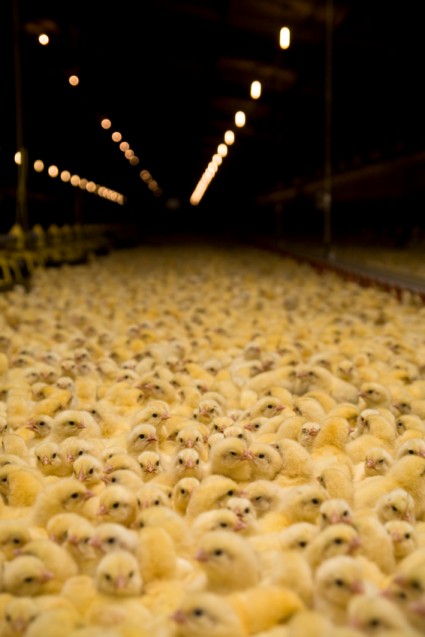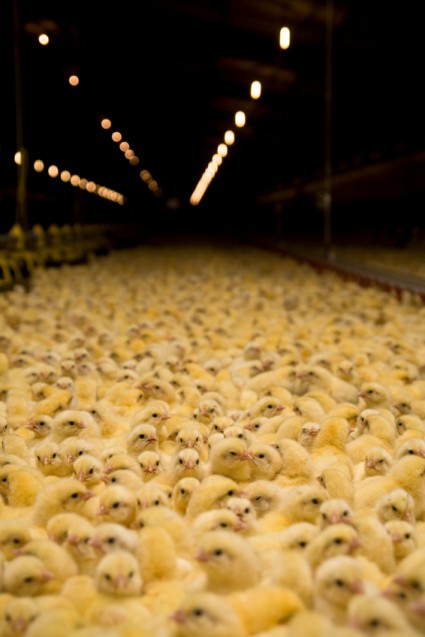Well, Brazil-based beef behemoth JBS has announced a deal to take a two-thirds stake of struggling U.S. poultry titan Pilgrim’s. (Evidently, company founder “Bo” Pilgrim couldn’t stand to sever all ties with the company that he drove into bankruptcy with his relentless zeal to grow bigger and bigger.)
JBS also announced a surprise deal to buy one of its biggest Brazilian rivals, the beef processor Bertin. Before the deals, JBS was already the globe’s largest beef processor, with a jaw-dropping 10 percent of the worldwide beef market. If the two deals make it past U.S. and Brazilian antitrust authorities, JBS will leapfrog Tyson as the globe’s largest meat company; it will have about $30 billion in annual revenue, compared to Tyson’s $26.7 billion, Reuters reports. (Cargill has $120 billion in annual revenue, but its interests extend well beyond meat to grain trading, fertilizer, biofuel, and even a hedge fund).
And thus, four gigantic companies now dominate meat production here.
Well, not quite yet. There is that matter of antitrust. But while the Obama Administration has rattled its sword at unchecked agribiz consolidation, hardly anyone expects it to block this tie-up. Before the deal, JBS had huge positions (see chart) in the U.S. beef and pork markets; but none in chicken. So the logic goes like this: by taking out Pilgrim’s, JBS isn’t reducing the number of players in the chicken market–and thus there are no grounds for blocking the deal.
The Obama Justice Department will likely buy that line. I don’t, though. The deal would leave two companies–JBS and Tyson–with enormous positions in beef, pork, and chicken, the crown jewels of the supermarket meat case. Both companies will be able to offer huge retailers like Wal-Mart and Safeway the full range of meat options, giving them an advantage over smaller players focused on a single commodity. (Two other companies, Cargill and Smithfield, have massive positions in at least two meat commodities, but can’t boast the beef-pork-chicken triple play.)
And to grab prime shelf space for its product line, JBS and Tyson might be tempted to sacrifice profits in one commodity in hopes of gaining higher profits in another. JBS could, say, entice Wal-Mart to prominently feature its whole line of products by slashing beef prices in hopes of booking profits on chicken and pork. Such a strategy might work for JBS’s own bottom line– but be a disaster for the ranchers who supply it with beef cows.
As market consolidation in the meat industry proceeds apace, the surviving independent livestock farmers (they’re really CAFO operators) face ever-heavier downward pressure on the prices offered by the few remaining big processors. That means more pressure to stuff as many animals as possible into confinement facilities, and more pressure to dispose as cheaply as possible of the vast mountains of waste generated thereby.
Thus, likely, more public-health troubles like MRSA and antibiotic-resistant salmonella (see below); and more contribution to slow-motion environmental disasters like polluted rivers, fouled drinking water, and–granddaddy of all–climate change.
*
Info for chart comes from the following sources:
— Brazilians Bid for U.S. Meat Titan, The Wall Street Journal
— U.S. seen approving a JBS-Pilgrim’s Pride deal, Reuters
— Concentration of Agriculture Markets, April 2007 [PDF], by Mary Hendrickson and William Heffernan
— JBS Eyes Top Spot with Pilgrim’s, Bertin Deals, Reuters
• Yet the U.S. meat industry is in crisis–demand growth is slack because of the bad economy, and profits are now low, at best, for the meat giants. Why is JBS moving so aggressively into the U.S.? (Its U.S. buying spree started last year, when its snapped up Swift’s beef and pork assets and Smithfield’s beef operations.) Why buy a struggling chicken giant?
One reason is that Pilgrim’s Pride was so damned cheap. The company’s hard-driving founder, “Bo” Pilgrim, had taken on a mountain of debt to propel the company to the top of the poultry pecking order. As recently as last year, Pilgrim’s was the globe’s largest poultry processor, with more than 20 percent of the U.S. market (a few percentage points more than arch-rival Tyson) and a robust export business.
But when the financial crisis hit last year, chicken prices plunged, and Pilgrim’s creditors grew antsy about refinancing debt. Engulfed in a cash crunch, Pilgrim’s had to declare bankruptcy and shutter some plants. (There was widespread speculation that Tyson intentionally held down chicken prices to push Pilgrim’s over a cliff.) Pilgrim’s Pride’s market share fell to below 20 percent; Tyson regained the crown of U.S. chicken king.
Meanwhile, investors rushed to sell PP’s stock, which has since traded at pennies on the dollar from 2007 levels. So in stepped deep-pocketed JBS. For about $2.8 billion, the company is getting about a fifth of the U.S. chicken market–a bargain, especially if chicken prices recover along with the economy. JBS is betting that when the U.S.–and perhaps more important, the global–economy picks up, a fifth of the chicken market will be worth a lot more than $2.8 billion.
• Really, this deal seems to be about exports–a play on rising global demand for cheap meat. Even in the best of times, overall demand for meat in the U.S. is stagnant, rising only at the sluggish rate of population growth. Meat companies boost profits in two ways: 1) by squeezing their suppliers (farmers) on price and slaughterhouse workers on wages; and 2) expanding into foreign markets. At this point, the real cash is to be made through access to places like Asia and Eastern Europe, where demand is rising rapidly. And U.S. companies have been masterful at gaining access to those markets–which is probably why JBS is so interested in alighting here.
“In terms of benefits, it [the JBS-Pilgrim’s deal] is a global story rather than a U.S. story,” one analyst told Reuters. “They well understand the international focus. When (about) 20 percent (of U.S. chicken) is exported, they see some potential in that poultry complex from a global demand perspective.”
 Bright lights, Big ChickenSo the deal is really about globalizing the disastrous U.S. relationship with meat–making sure that the rest of the world, too, comes to see it as a cheap everyday commodity to be raised under ecologically and socially devastating conditions.
Bright lights, Big ChickenSo the deal is really about globalizing the disastrous U.S. relationship with meat–making sure that the rest of the world, too, comes to see it as a cheap everyday commodity to be raised under ecologically and socially devastating conditions.
• Sometimes, U.S. meat and dairy companies focus on exporting their dubious wares to countries in the developing world; other times, they focus on establishing vast, largely unregulated facilities there, as pork giant Smithfield has done to disastrous effect (unless you own Smithfield shares) in Mexico and Poland.
Then there’s companies that peddle their wares as consultants, selling their expertise in setting up huge industrial-scale livestock operations in places where small farmers still do things outdoors on pasture. That’s what the Wisconsin firm Cooperative Resources International is getting up to in China.
From an account in the Milwaukee Business Journal:
Cooperative Resources International, a dairy and beef genetics agricultural cooperative, has entered into a long-term agreement with Flying Crane Dairy, one of China’s largest producers and distributors of premium infant formula and milk powder.
Cooperative Resources (CRI) has worked extensively with the state of Wisconsin to develop international relationships and trade. It is one of the largest U.S. suppliers of cattle semen to China.
So we’ve got a tie-up between a Wisconsin cattle-semen outfit and a Chinese infant formula supplier here, facilitated by the state of Wisconsin and its taxpayers. What’s the plan?
Under the agreement, CRI will advise Flying Crane, which intends to construct 10 additional dairy farms to house 10,000 dairy cows at each facility in order to increase its milk processing capacity to a goal of 5,000 tons per day.
Nice! That’s what the world needs now–ten more gigantic dairy feedlots. Way to use that Wisconsin ingenuity to export industrial dairy production to a country with no dairy tradition!
• Finally, Meat Wagon takes a detour from the bleaker regions of industrial agriculture and lurches down the uncharted path toward hope. Rep. Louise Slaughter (D.-New York) has formally petitioned the GAO to review how the federal government tracks antibiotic use on factory farms.
This is potentially a huge deal. Animals that live crammed together over their own waste tend to see their immune systems flag and become vulnerable to disease. Today’s CAFOs rely on steady doses of antibiotics just to keep animals alive. Moreover, scientists discovered a generation or so ago that regular doses of antibiotics make animals grow faster–a key consideration for livestock farmers facing chronically low prices for their goods.
The problem is obvious: where antibiotics are used routinely, antibiotic-resistant “superbugs” thrive.
As it stands now, information on factory-animal farm antibiotic use is maddeningly opaque. A tangle of agencies–the FDA, CDC, and USDA–ostensibly monitor the topic; but none has direct responsibility for measuring and reporting it. As a result, no one has more than the vaguest estimate of overall use.
A couple of years ago, the Union of Concerned Scientists stepped into the void and ventured a guess. Extrapolating from raw data, the group estimated that as much as 70 percent of antibiotics used in the U.S. go into animal factories. The meat industry shrieked in protest, rushing out a rival study with a much lower number.
Meanwhile, the federal agencies kept quiet–and evidence of links between antibiotic-dependent CAFOs and antibiotic-resistant pathogens (MRSA and salmonella) has mounted.
As Slaughter’s letter points out, the GAO has chastised the federal government for its failure to track antibiotics before. Writes Slaughter:
[I]n a 2005 report entitled Antibiotic Resistance: Federal Agencies Need to Better Focus Efforts to Address Risk to Humans from Antibiotic Use in Animals, GAO found that data were not being collected on the types and amounts of antibiotics used in different species of food animals or whether they were used to promote growth, prevent disease, or treat disease.
So now, Slaughter is demanding followup. Any progress since 2005? If not, why not–and when?
Slaughter is also sponsoring an important bill called HR 1549, which would ban routine use of antibiotics on farms. Predictably, the meat industry is using all its lobbying might to fight it.
Of course, the federal government’s know-nothing response to antibiotic levels plays to the industry’s interests. It’s difficult to address a problem when your unclear as to it scope. For a solid understanding of why we need to know how much antibiotics are being guzzled by CAFOs–and why we need to stop their routine use as livestock feed supplements–see the fantastic article “Farmocology” in a recent issue of Johns Hopkins Magazine.
Here’s a sample:
The United States Department of Agriculture (USDA) estimates that livestock and poultry produce 335 million tons of manure per year, which is one way [antibiotic-]resistant pathogens get out of animals and into the environment. That’s 40 times as much fecal waste as humans produce annually. Farms use it for fertilizer and collect it in sheds and manure lagoons, but those containment measures do not prevent infectious microbes from getting into the air, soil, and water. They can be transported off the farms by the animals themselves, houseflies, farm trucks, and farm workers, and by spreading manure on other fields. Out in the environment, they form a sort of bank of genetic material that enables the spread of [antibiotic] resistance.




